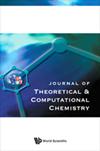The mutual noncovalent interactions based on metallophilic cluster and anions: A theoretical investigation of the molecular structure and spectroscopic properties of Host–Guest complexes
IF 2.4
Q3 Computer Science
Journal of Theoretical & Computational Chemistry
Pub Date : 2019-11-04
DOI:10.1142/s0219633619500287
引用次数: 1
Abstract
The d[Formula: see text] metallophilic host clusters [Au(NHC)2][Formula: see text] [M(CN)2][Formula: see text] [Au(NHC)2][Formula: see text](NHC [Formula: see text] N-heterocyclic carbene, [Formula: see text], Ag) with high phosphorescence are synthesized recently and their phosphorescent modulation by solvents is investigated in theory. In this paper, the guest anions (F−, Cl−, Br−, NO[Formula: see text], and BF[Formula: see text] are used to elucidate their effects on metallophilic interactions and phosphorescence of hosts, and also they served as the probes to study the recognition characters of metallophilic hosts. The calculation shows that the guest anions can mutually interact with the host clusters and further, which can modulate the metallophilic Au[Formula: see text]M distances and the phosphorescence spectra of the hosts.基于亲金属簇和阴离子的非共价相互作用:主客体配合物分子结构和光谱特性的理论研究
最近合成了具有高磷光性的d[式:见文]亲金属宿主团簇[Au(NHC)2][式:见文][M(CN)2][式:见文][Au(NHC)2][式:见文](NHC[式:见文]n -杂环卡宾,[式:见文],Ag),并从理论上研究了溶剂对其磷光的调制作用。本文以客体阴离子F−、Cl−、Br−、NO[公式:见文]、BF[公式:见文]为研究对象,阐明了它们对宿主亲金属相互作用和磷光的影响,并作为探针研究了亲金属宿主的识别特性。计算表明,客体阴离子可以与宿主团簇相互作用并进一步相互作用,从而调节亲金性Au[公式:见文]的M距离和宿主的磷光光谱。
本文章由计算机程序翻译,如有差异,请以英文原文为准。
求助全文
约1分钟内获得全文
求助全文
来源期刊
CiteScore
1.70
自引率
0.00%
发文量
0
审稿时长
3 months
期刊介绍:
The Journal of Theoretical and Computational Chemistry (JTCC) is an international interdisciplinary journal aimed at providing comprehensive coverage on the latest developments and applications of research in the ever-expanding field of theoretical and computational chemistry.
JTCC publishes regular articles and reviews on new methodology, software, web server and database developments. The applications of existing theoretical and computational methods which produce significant new insights into important problems are also welcomed. Papers reporting joint computational and experimental investigations are encouraged. The journal will not consider manuscripts reporting straightforward calculations of the properties of molecules with existing software packages without addressing a significant scientific problem.
Areas covered by the journal include molecular dynamics, computer-aided molecular design, modeling effects of mutation on stability and dynamics of macromolecules, quantum mechanics, statistical mechanics and other related topics.

 求助内容:
求助内容: 应助结果提醒方式:
应助结果提醒方式:


